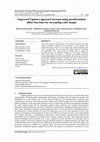Papers by ABDELLATIF JARJAR
Multimedia Tools and Applications, 2021
This article tracks the development of a new algorithms supported by the abundant Vigenere lap, f... more This article tracks the development of a new algorithms supported by the abundant Vigenere lap, followed by two deeply improved Feistel lathes, acting on arbitrary-sized nucleotide blocks calculated from the chaos map used. This step can be ensured by adapting the basic gWith the progress of the theory of some mathemenetic operator to encrypt the color image. At the end of the second round, mutations and genetic crosses will be applied on the global image. Finally, a passage to the codons writing with the intention of modification of the released protein, extracting the Exons, Introns and Stop codons. Testing on a large number of different sizes images and formats randomly selected from the color image database ensures that our system can endures any known attacks.

Sensing and Imaging, 2021
In order to augment the resistance against any possible known attack, this paper develops a new t... more In order to augment the resistance against any possible known attack, this paper develops a new technique for medical and color image encryption using deep refinements of three classical systems. Two new substitution matrices and their replacement functions will be generated from the chaotic maps used, for an improved Vigenere technique application. At the departure from the Vigenere rotation, the vector is subdivided into sub-blocks with size calculated from the installed chaos, for an engineered application comprising two Feistel rotations supported by genetic operators appropriate for image encryption. In parallel, a new technique traces the building of a large invertible matrix, for an extension of the classical Hill technique. This last method will be assisted by dynamic vectors to exclude any linearity. A solid chaining is established between the encrypted block and the next clear block to avoid any differential attack. Simulations carried out on a large volume of images of different sizes and formats ensure that our approach is not exposed to known attacks.
The largest part of the image encryption algorithms operates on the pixel as a central element by... more The largest part of the image encryption algorithms operates on the pixel as a central element by implementing diffusion confusion and eventually a permutation. On the other side, a permutation applied at the bit level changes not only the pixel value, but also its location within the image. In this work, we will propose a new technology of medical and color image encryption, based on chaotic permutations acting at the bit level, and a diffusion confusion ensured by an application of the method of Vigenere largely improved and adapted to the subject. Simulations performed on a large number of images of different sizes and formats ensure that our method is not subject to any known attacks.
International journal of statistics and applied mathematics, 2016
This paper traces the process of constructing a new one-dimensional chaotic map, and will provide... more This paper traces the process of constructing a new one-dimensional chaotic map, and will provide a simple application in color image encryption. The use of Sakovskii's theorem will make it possible to determine the existence of chaos and restrict all conditions to ensure the existence of this new sequence. In addition, the sensitivity to initial conditions will be proved by Lyapunov's index value. Similarly, the performance of this new chaotic map will be illustrated graphically and compared with other chaotic maps most commonly used in cryptography. Finally, a humble color image encryption application will show the power of this new chaotic map.
International journal of safety and security engineering, Feb 29, 2024
International Journal of Advanced Science and Computer Applications, Dec 25, 2023
Medical & Biological Engineering & Computing, May 17, 2022
Medical & Biological Engineering & Computing
Journal of Multimedia Information System, 2021
This paper traces the process of constructing a new one-dimensional chaotic map, and will provide... more This paper traces the process of constructing a new one-dimensional chaotic map, and will provide a simple application in color image encryption. The use of Sarkovskii's theorem will make it possible to determine the existence of chaos and restrict all conditions to ensure the existence of this new sequence. In addition, the sensitivity to initial conditions will be proved by Lyapunov's index value. Similarly, the performance of this new chaotic map will be illustrated graphically and compared with other chaotic maps most commonly used in cryptography. Finally, a humble color image encryption application will show the power of this new chaotic map.
Acadlore transactions on AI and machine learning, Jun 26, 2024
Multimedia tools and applications, Apr 27, 2024

International Journal of Power Electronics and Drive Systems/International Journal of Electrical and Computer Engineering, Jun 1, 2024
This article presents an improvement to the traditional Vigenere encryption method, specifically ... more This article presents an improvement to the traditional Vigenere encryption method, specifically adapted for the encryption of color images. This enhancement relies on the use of two chaotic maps widely employed in the field of cryptography. After vectorizing the original image and calculating the initialization value, which alters the seeding pixel to trigger the encryption process, our approach integrates two new large substitution tables. These tables are linked to confusion and diffusion functions, incorporating multiple reversible pseudo-random affine functions at the pixel level. Finally, a global permutation is applied to the entire resulting vector to increase the temporal complexity of potential attacks on our system. Simulations conducted on a diverse set of images of various sizes and formats demonstrate the resilience of our approach against any unexpected attacks.
Studies in computational intelligence, 2024

Acadlore transactions on AI and machine learning, Mar 14, 2024
In the realm of digital image security, this study presents an innovative encryption methodology ... more In the realm of digital image security, this study presents an innovative encryption methodology for color images, significantly advancing the traditional Vigenere cipher through the integration of two extensive pseudorandom substitution matrices. These matrices are derived from chaotic maps widely recognized for their cryptographic utility, specifically the logistic map and the skew tent map, chosen for their straightforward implementation capabilities in encryption systems and their high sensitivity to initial conditions. The process commences with the vectorization of the original image and the computation of initial values to alter the starting pixel's value, thereby initiating the encryption sequence. A novel aspect of this method is the introduction of a Vigenere mechanism that employs dynamic pseudorandom affine functions at the pixel level, enhancing the cipher's robustness. Subsequently, a comprehensive permutation strategy is applied to bolster the vector's integrity and elevate the temporal complexity against potential cryptographic attacks. Through simulations conducted on a varied collection of images, encompassing different sizes and formats, the proposed encryption technique demonstrates formidable resilience against both brute-force and differential statistical attacks, thereby affirming its efficacy and security in safeguarding digital imagery.
International Journal of Advanced Science and Computer Applications, Mar 14, 2024
International journal of safety and security engineering, Feb 29, 2024

Medical imaging process & technology, Feb 20, 2024
The purpose of this research is to develop a new method for encrypting multiple superimposed or s... more The purpose of this research is to develop a new method for encrypting multiple superimposed or side-by-side images. The process begins by extracting the red, green, and blue channels from each image and converting them into vectors that combine to produce a single image that undergoes an advanced pixel-level Vigenere transform. In the next step, a pseudorandom transition occurs at the nucleotide, followed by a passage to codons for genetic crossover implementation specifically designed for image scrambling. The latter process is controlled by many random tables developed from selected chaotic maps, which ensures a high degree of flexibility and security in the encryption method. To evaluate the effectiveness and security of this innovative multi-image encryption algorithm, extensive simulations were performed using a large number of images randomly selected from the database. The simulation results prove the reliability and robustness of the method.










Uploads
Papers by ABDELLATIF JARJAR